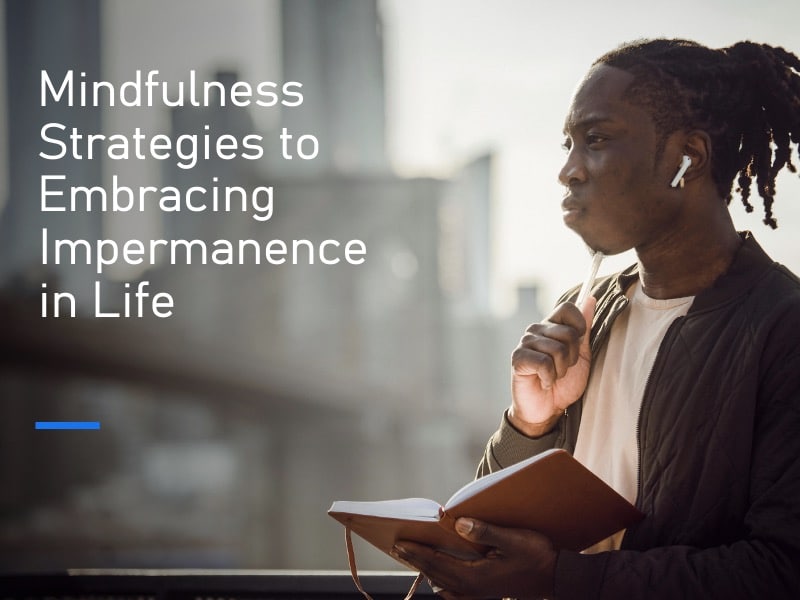Mindfulness Strategies to Embracing Impermanence in Life
Embracing impermanence is one of the most powerful shifts you can make in your perspective on life.
Everything evolves: our relationships, emotions, health, and even our sense of self.
This universal truth, known as impermanence, often provokes discomfort and fear.
But learning to embrace impermanence can profoundly improve your mental, emotional, and even physical health.
Through mindfulness, we can navigate uncertainty with greater ease, deepen our appreciation, and cultivate a more peaceful, present-centered life.
Mindfulness, which has roots in ancient Buddhist psychology and is now widely used in cognitive therapy, teaches us to stay aware in the moment without resistance or judgment.
Practicing mindfulness doesn’t eliminate discomfort or protect us from change, but it enables us to remain engaged, resilient, and compassionate in the face of life’s fluctuations (Kabat-Zinn, 1994).
Through this lens, embracing impermanence becomes not a source of anxiety, but a path toward deeper gratitude, connection, and trust.
What Does it Mean to Embrace Impermanence in Life?
To embrace impermanence means to fully acknowledge that everything in life is temporary: your emotions, circumstances, relationships, successes, and even your physical body.
Rather than resisting or fearing change, you learn to accept it with openness and presence.
Embracing impermanence doesn’t mean giving up or becoming detached; it means living with deeper appreciation, knowing that each moment is fleeting and therefore more precious.
This mindset helps you release unhealthy attachments, reduce anxiety about the future, and stay grounded in the here and now.
Spiritually, it reflects trust in something greater than yourself—placing faith not in what is constantly shifting, but in the deeper meaning and purpose behind it all.

Understanding Impermanence Through Mindful Awareness
The concept of impermanence isn’t just philosophical, it’s deeply practical. From the highs of success to the lows of illness or loss, everything is temporary.
Accepting this isn’t about detachment or nihilism. Instead, it encourages a deep appreciation of the present, knowing nothing is guaranteed to last.
One essential way to cultivate this mindset is through mindful meditation.
By focusing on the breath, bodily sensations, or ambient sounds, you return to the now, where life is always unfolding.
Regular meditation strengthens your ability to observe passing thoughts and feelings without becoming entangled in them, mirroring life’s impermanence without fear or reactivity (Tang et al., 2015).
Practices such as mindful journaling, where you write freely about emotions, experiences, or transitions, can also help you process and reflect on life’s temporary nature.
When you put your thoughts into words, you create emotional distance and clarity, allowing a more thoughtful and constructive response to change.
Even practical steps, such as organizing funeral plans, reflect mindfulness.
Rather than being morbid, this kind of foresight reduces future anxiety and affirms acceptance of life’s natural course. It’s a compassionate act for yourself and your loved ones.
Mindfulness Tools to Embrace Life’s Changing Nature
You don’t need to meditate for hours each day to cultivate mindfulness.
Many everyday practices can reinforce a mindset of acceptance and clarity, allowing you to handle life’s impermanence.
- Gratitude Practice: Start or end each day by noticing three things you’re grateful for. This keeps your attention grounded in the positive present and helps buffer against anxiety during periods of change.
- Movement-Based Mindfulness: As a professional athlete and fitness consultant, I’ve long used exercise as a mindfulness anchor. Whether it’s a strength workout, walking, or mobility training, physical movement connects you to the sensations of your body and grounds you in the now, making it easier to flow with change instead of resisting it.
- Mindful Eating: Slowing down to taste and enjoy your meals, such as fully appreciating the colors, textures, and smells, builds your mindfulness muscle in an enjoyable, accessible way. Food, too, reminds us that pleasure is transient, and every bite is an opportunity to live consciously.
- Connection with Nature: Nature is perhaps the most accessible and profound teacher of impermanence. Watching leaves fall, flowers bloom, or snow melt reveals how all things transform in time. This natural rhythm can soothe your mind and teach acceptance without forcing it.
How to Build Resilience Through Compassion and Presence
Acceptance is a cornerstone of embracing impermanence. It doesn’t mean giving up, it means letting go of unrealistic expectations that things will remain the same forever. When you’re facing a health issue, loss, or emotional upheaval, acceptance can reduce unnecessary suffering by removing the inner resistance that often magnifies pain.
Compassion, both toward yourself and others, is another key. When you recognize that everyone is navigating the same tides of change, empathy flows more naturally. Whether you’re grieving, growing, or simply adjusting, treating yourself with patience helps soften the emotional edges of change. For those who struggle with developing compassion, grief counseling is an effective, evidence-based treatment option.
Relationships especially benefit from this mindset.
Understanding that connections evolve helps you stay present and responsive.
You’re less likely to take people for granted and more likely to treasure your time with them.
Even simple daily routines, such as morning prayer, practicing breathing exercises, or sharing meals with your family, serve as meaningful touchpoints.
They help maintain emotional stability while honoring life’s movement.
The benefits of prayer, in particular, add a spiritual layer to impermanence, reminding you to place trust not in permanence, but in divine presence and purpose.
Jesus modeled this trust in divine purpose throughout His life, especially during moments of uncertainty and suffering. In the Garden of Gethsemane, He prayed with full awareness of the pain ahead, yet surrendered to God’s will, not clinging to earthly security, but trusting in the eternal plan of the Father (Matthew 26:39).
Jesus’s example reminds us that peace comes not from trying to control what changes, but from anchoring ourselves in God’s unchanging love and purpose.
Creative and Practical Expressions of Mindful Living
Creativity provides a profound outlet for navigating life’s transient moments.
- Art, music, poetry, or dance allow expression beyond language, helping process change and emotion.
- Creative work is inherently fluid and imperfect, mirroring the nature of life itself.
- Mindful breathing techniques also offer quick resets when you feel overwhelmed. Inhale deeply, hold briefly, and exhale slowly. Repeating this consciously grounds your mind and settles your body in moments of emotional turbulence.
- Lastly, mindful listening, being fully present in conversations without judgment, builds deeper human connections. Every conversation is a one-time event. When you embrace its impermanence, you honor its uniqueness and deepen your relationships.
Final Thoughts: Embracing Impermanence as a Path to a Fuller Life
Embracing impermanence through mindfulness isn’t about denying pain or change. It’s about learning to remain open-hearted in the face of it all.
This mindset fosters emotional flexibility, deeper gratitude, and a more authentic connection to yourself and others.
Mindfulness empowers you to let go, not to lose, but to live more freely, fully, and lovingly in the present.
As change remains life’s only constant, your ability to meet it mindfully becomes one of your greatest strengths.
Read Next: How to Stress Less
This website does not provide medical advice. This website site does contain affiliate links, and purchases may earn a commission.
Read my Medical Disclaimer, Review Disclaimer, and Publishing Policies for more details. Use of this site indicates acceptance of these terms.



